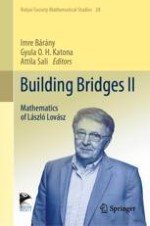2019 | OriginalPaper | Buchkapitel
Online Ramsey Numbers and the Subgraph Query Problem
verfasst von : David Conlon, Jacob Fox, Andrey Grinshpun, Xiaoyu He
Erschienen in: Building Bridges II
Verlag: Springer Berlin Heidelberg
Aktivieren Sie unsere intelligente Suche, um passende Fachinhalte oder Patente zu finden.
Wählen Sie Textabschnitte aus um mit Künstlicher Intelligenz passenden Patente zu finden. powered by
Markieren Sie Textabschnitte, um KI-gestützt weitere passende Inhalte zu finden. powered by
